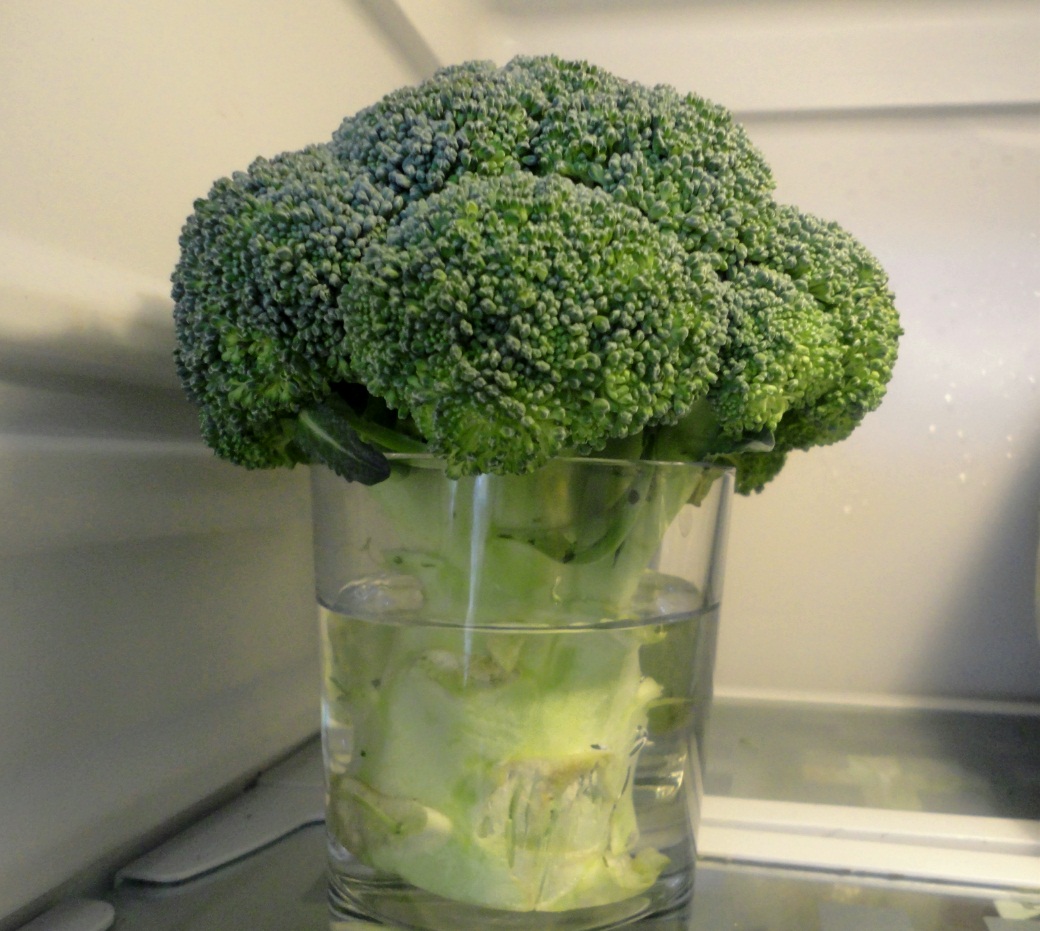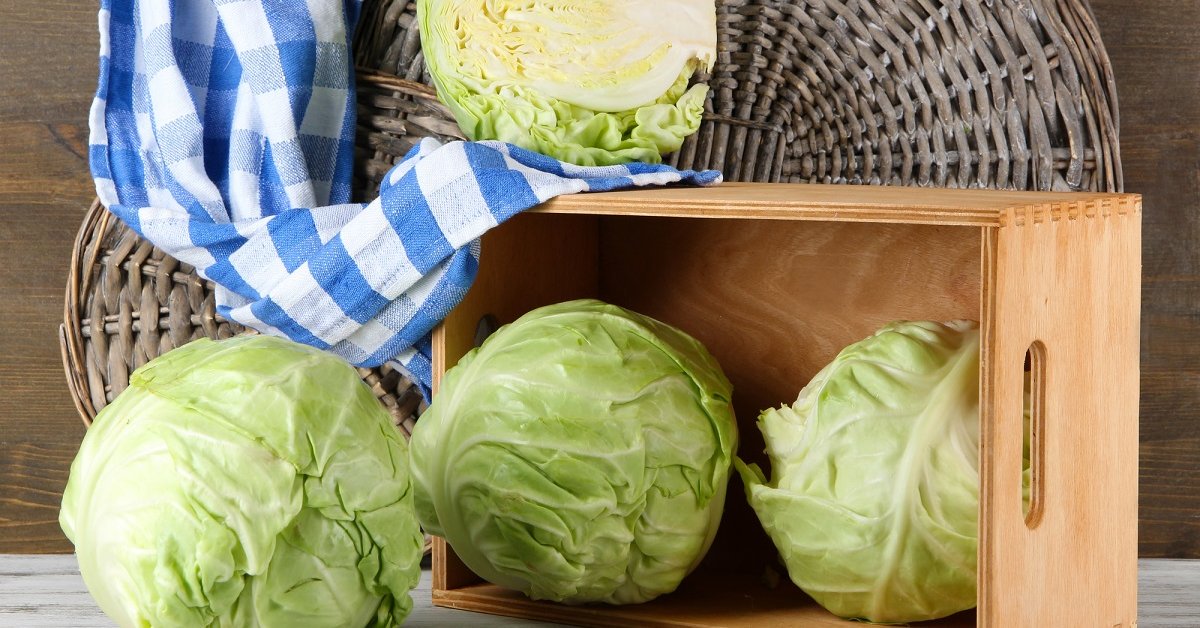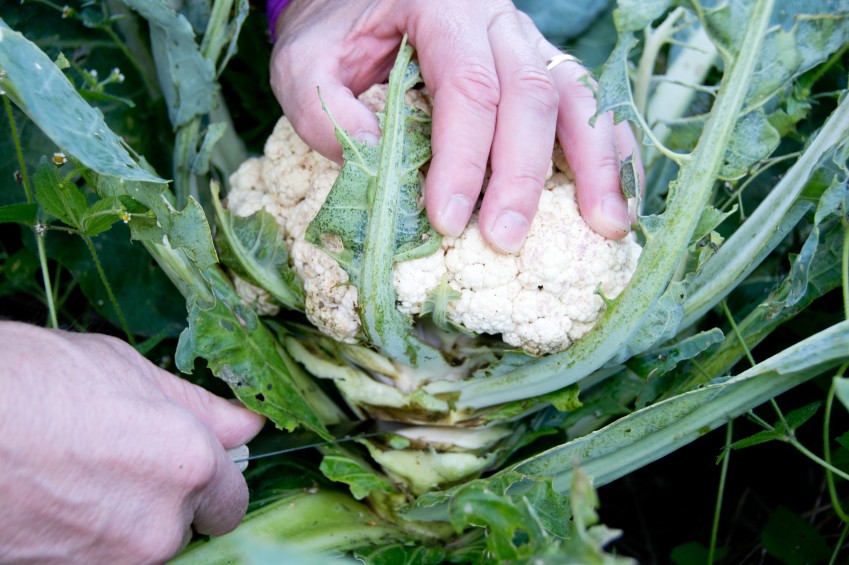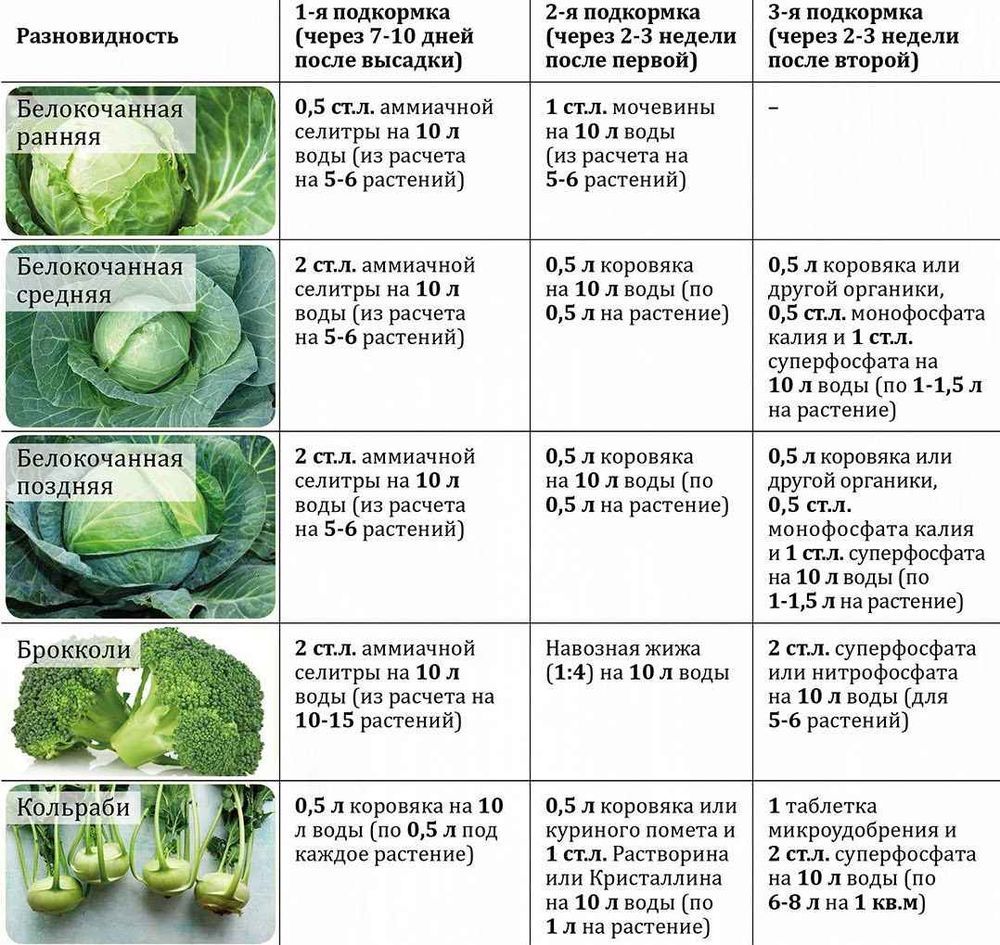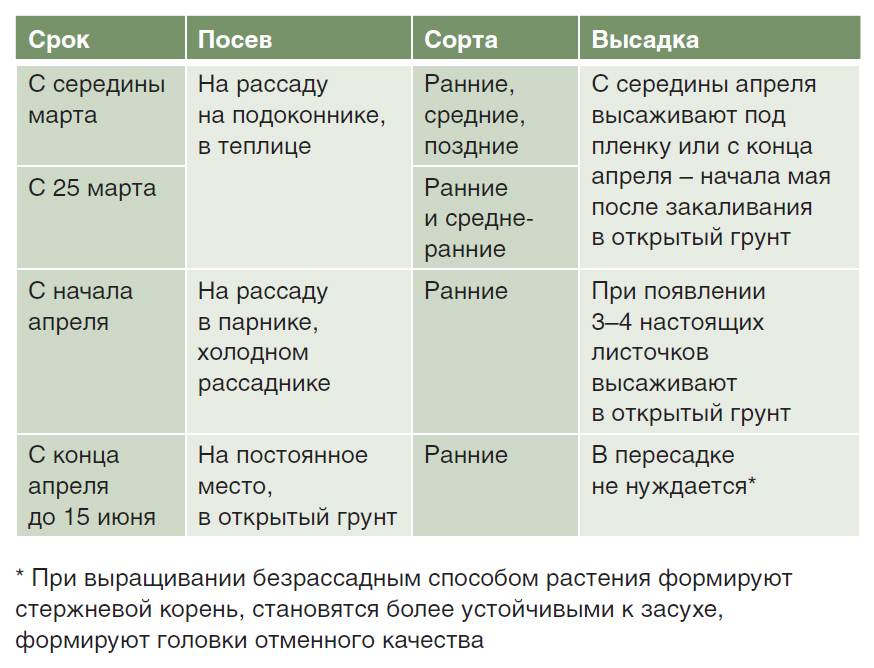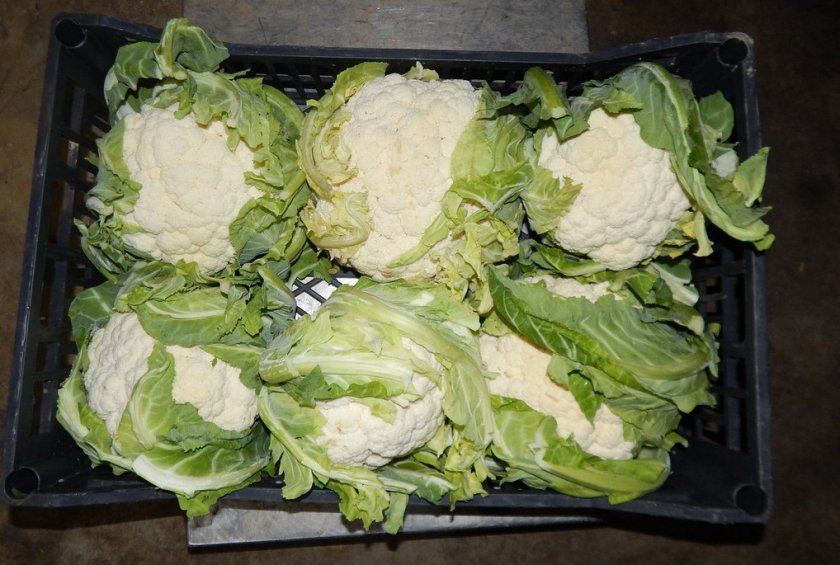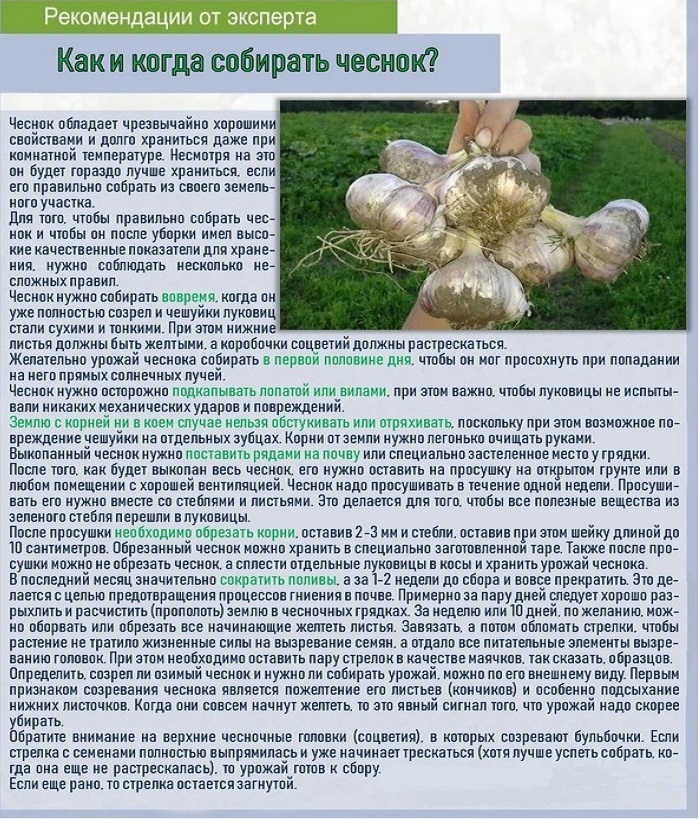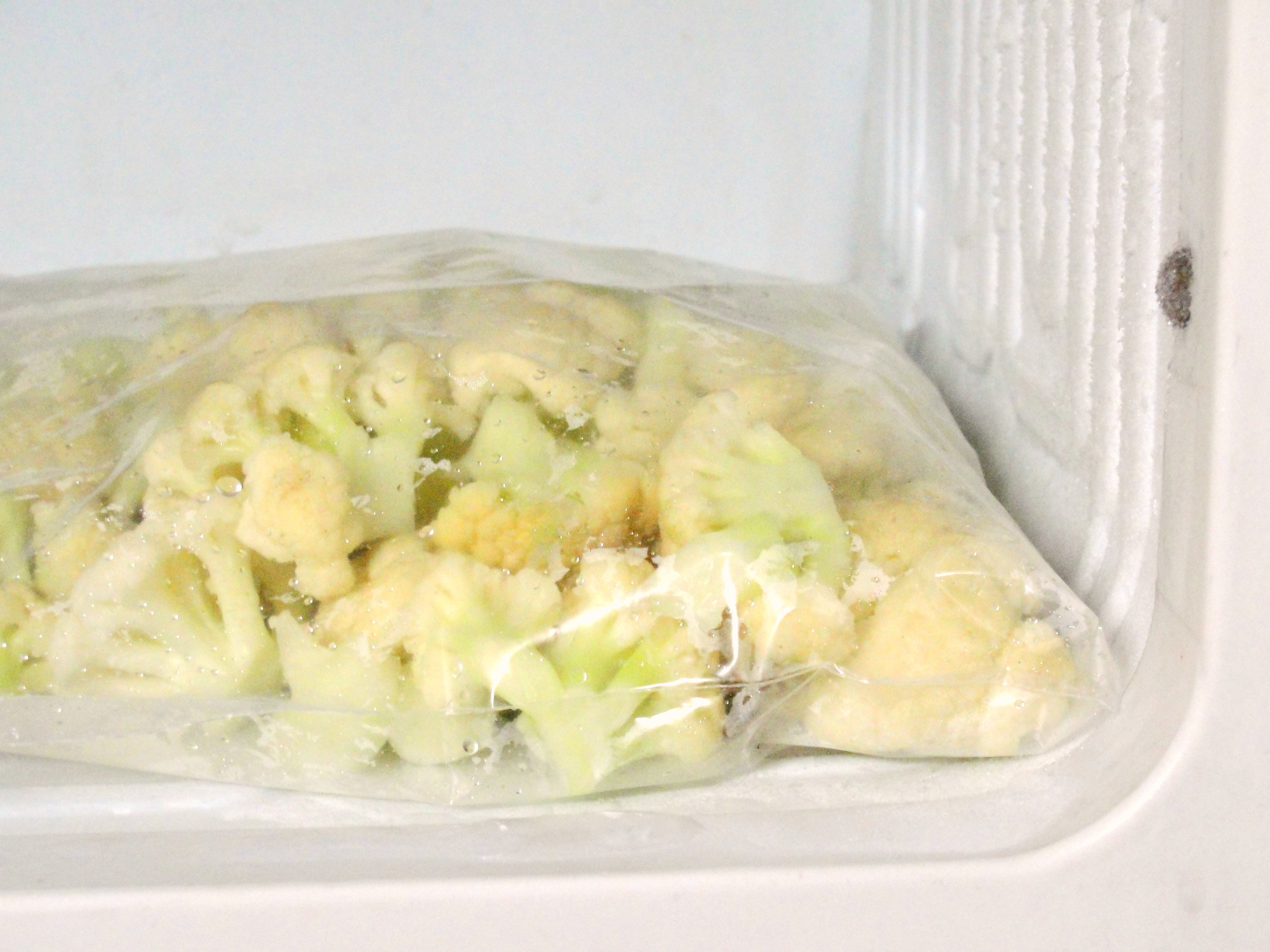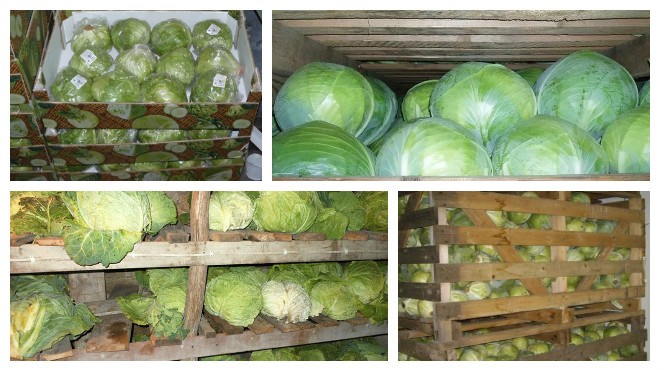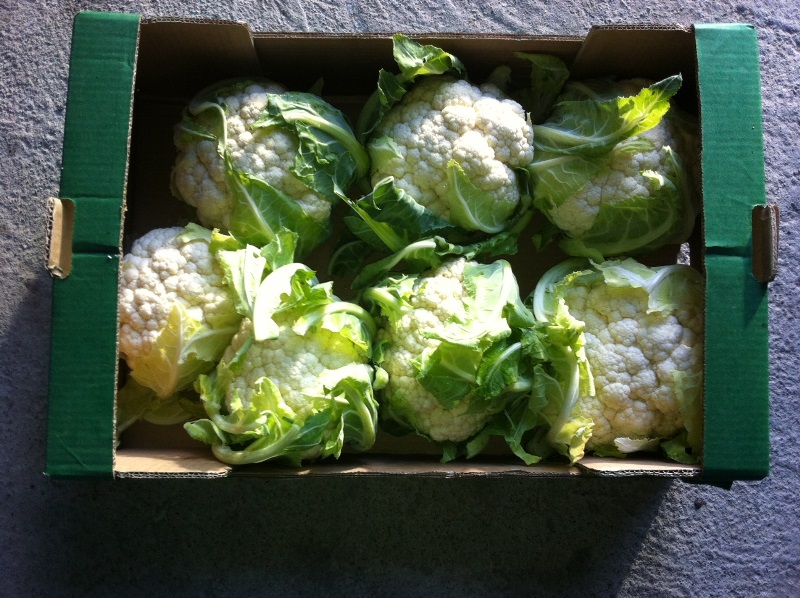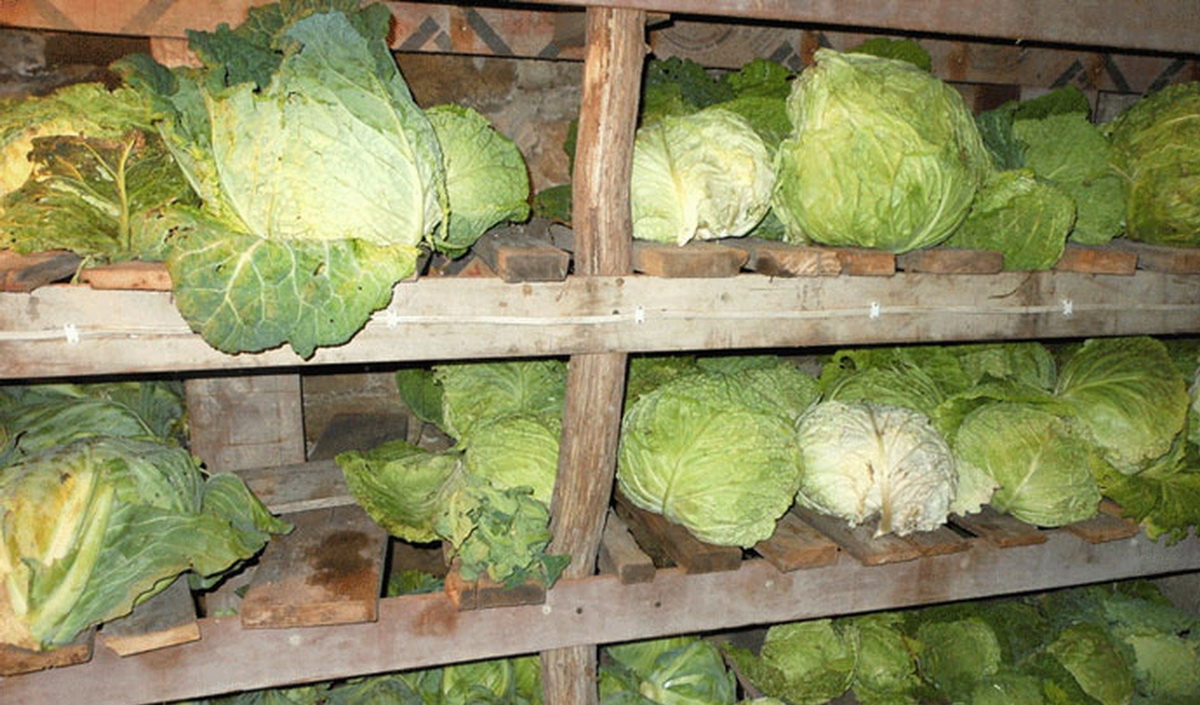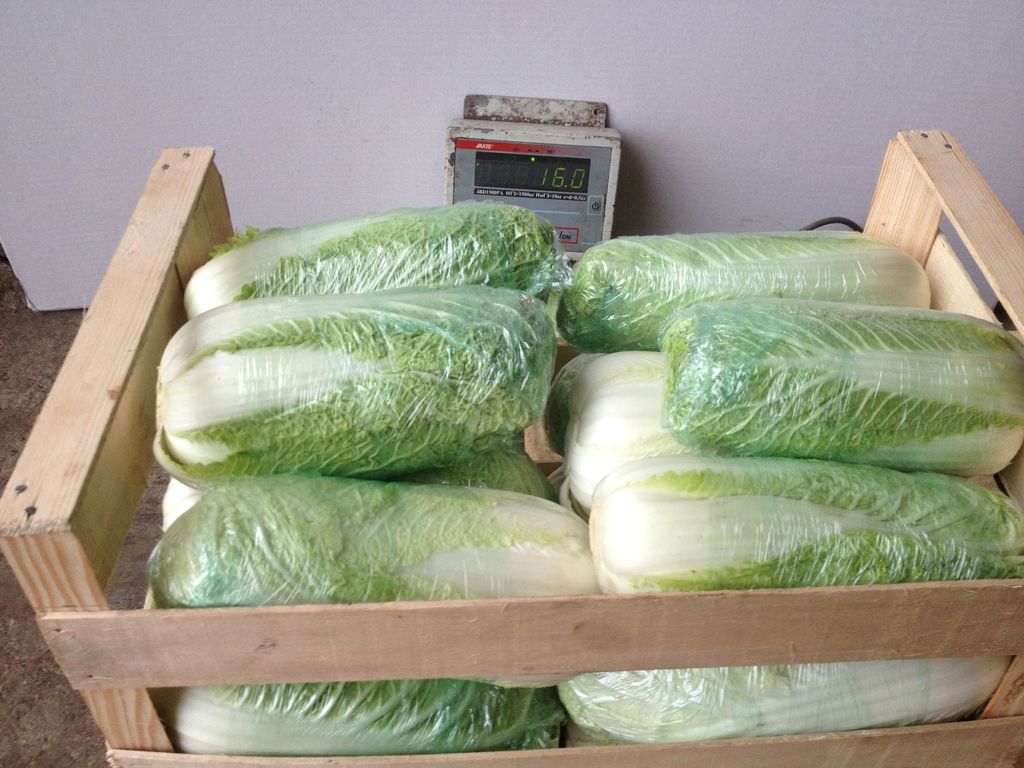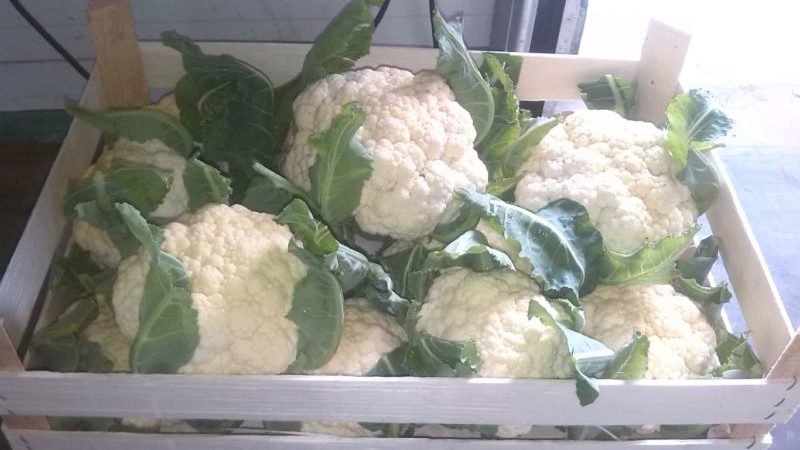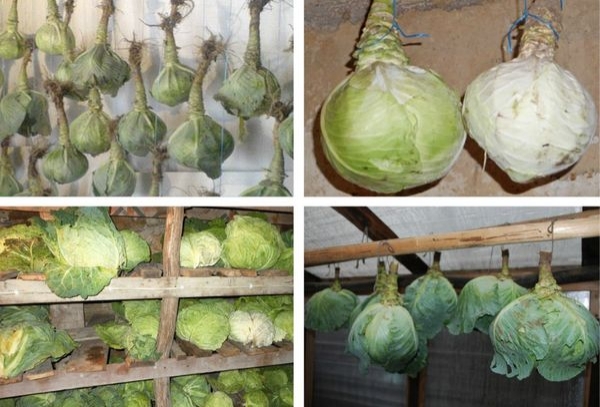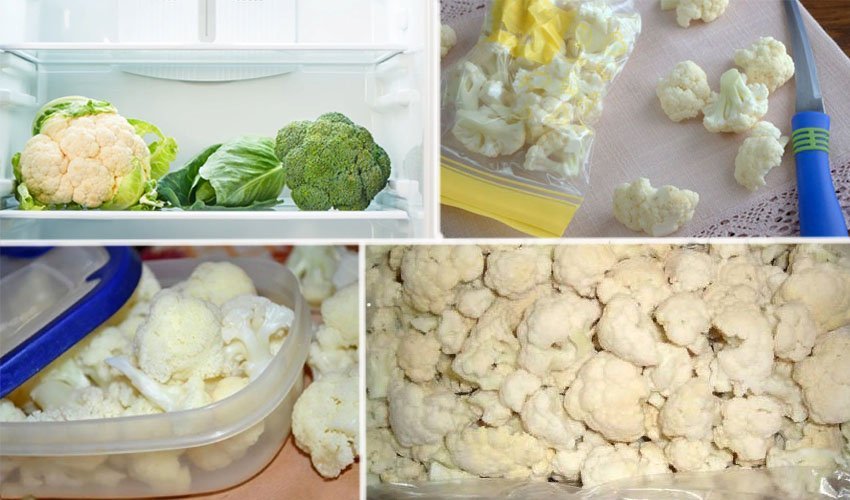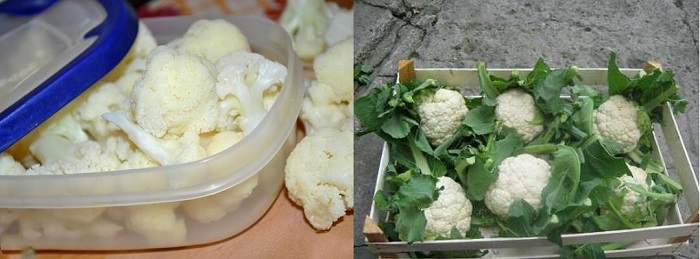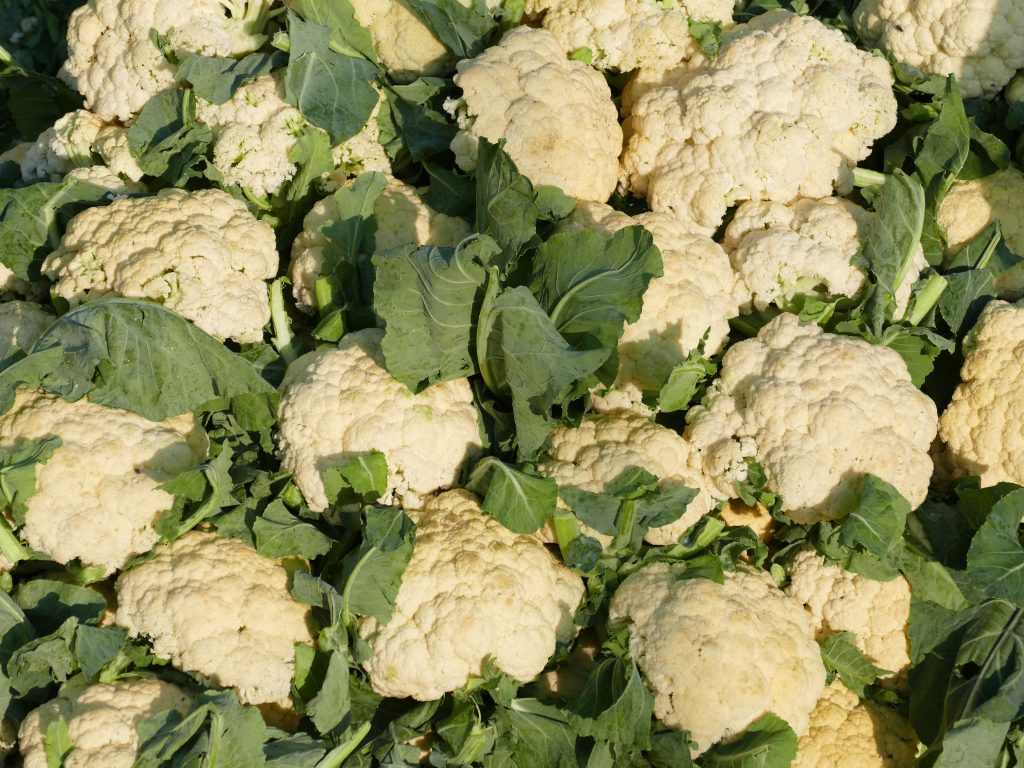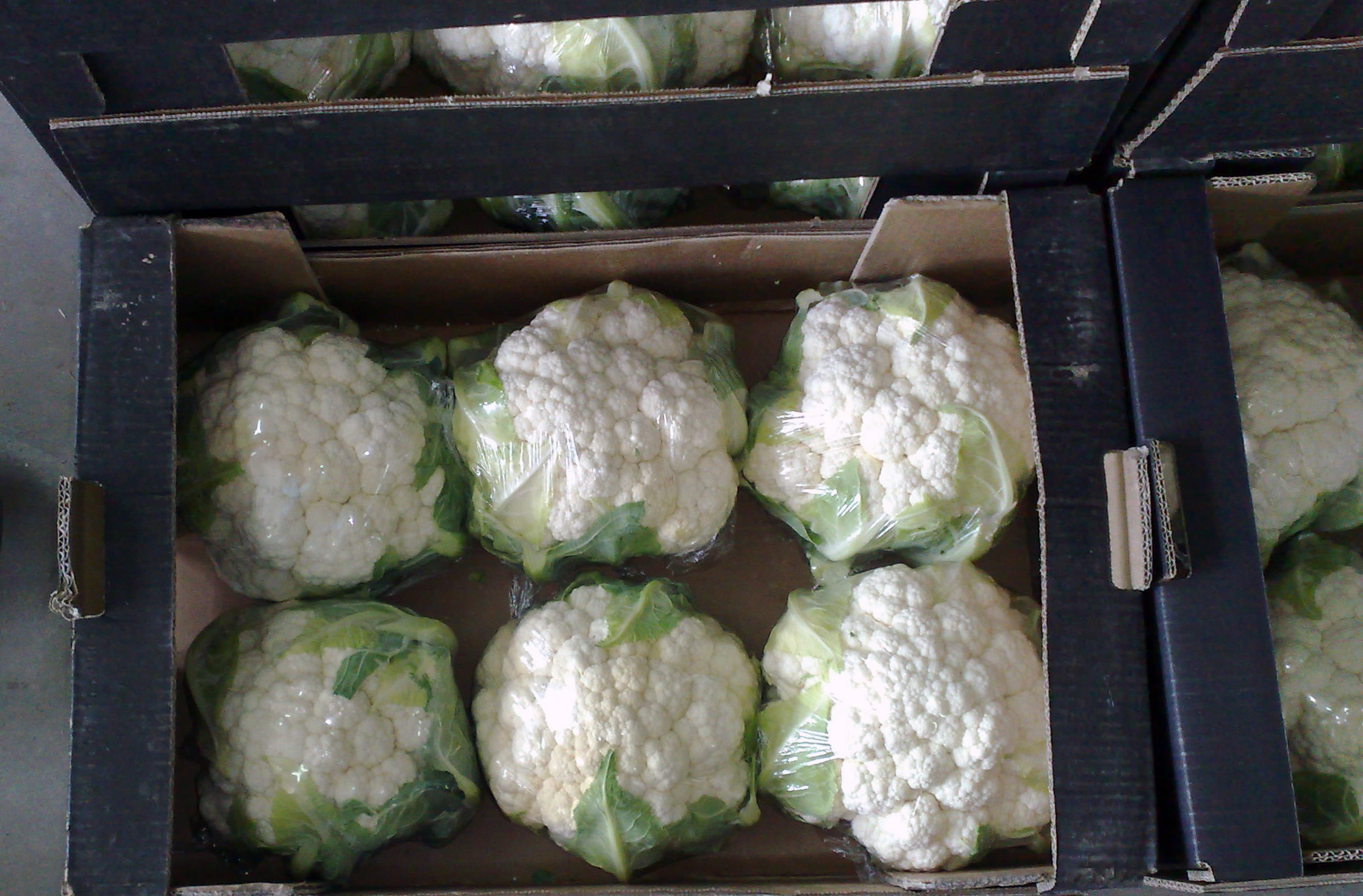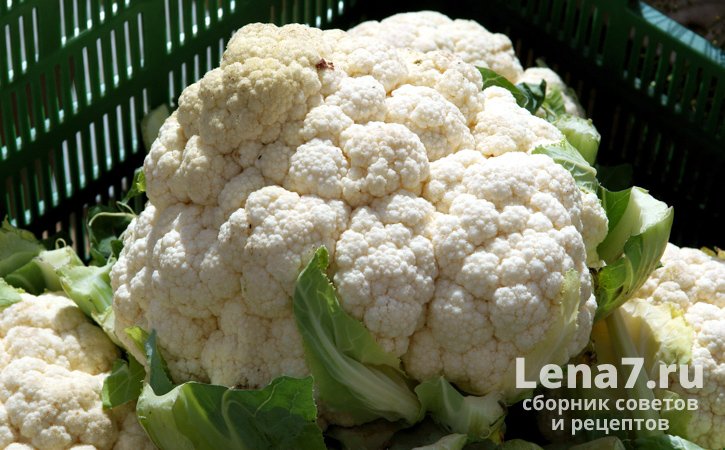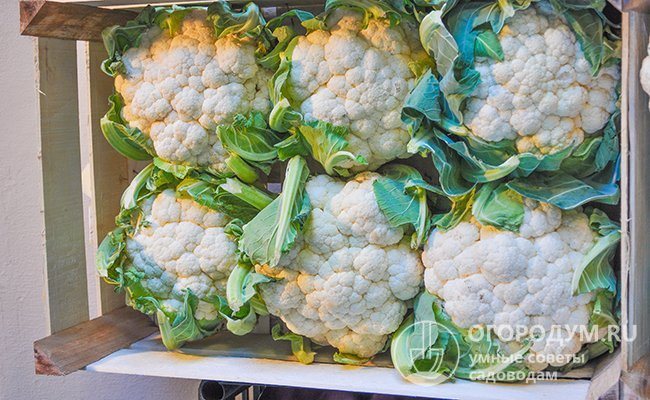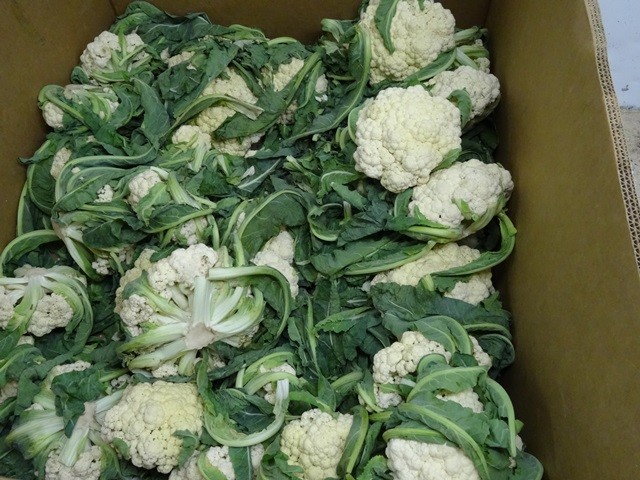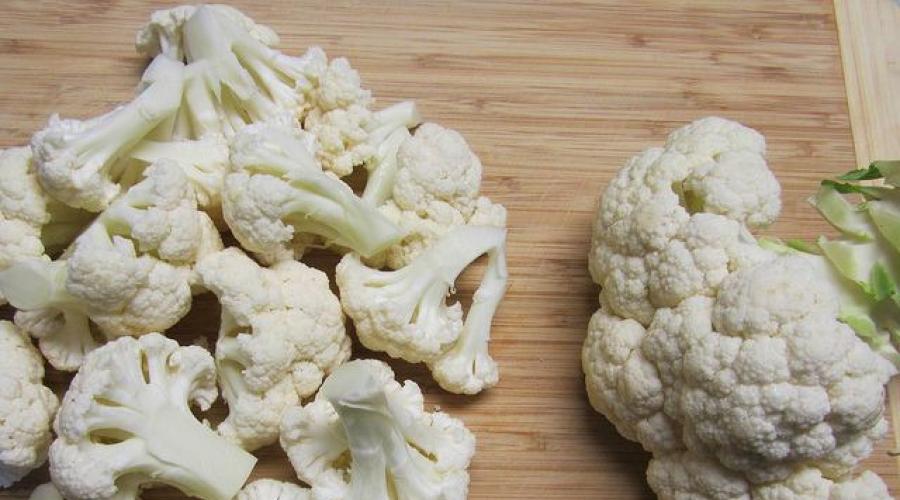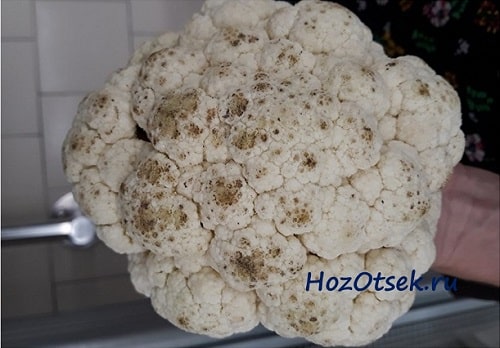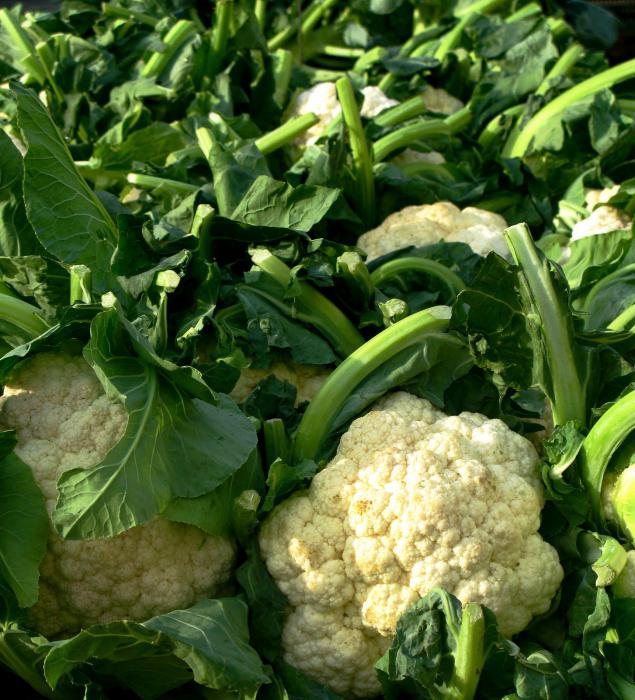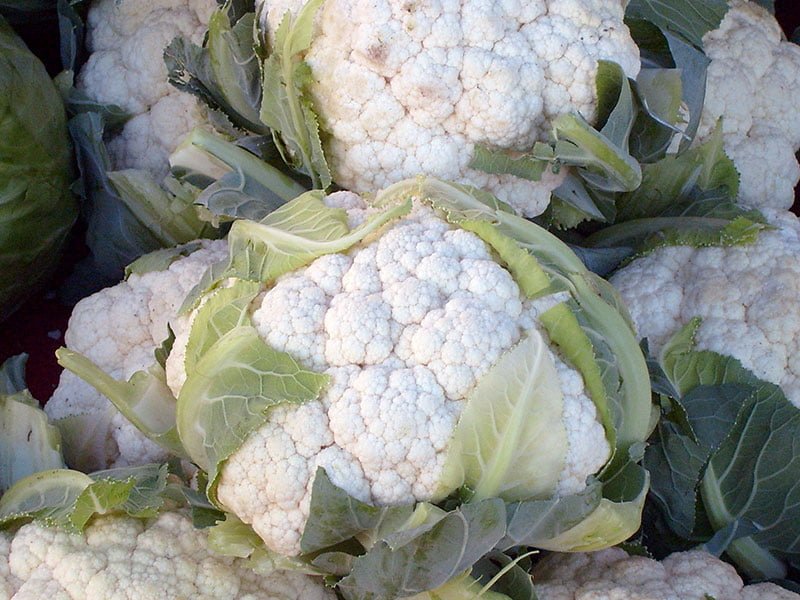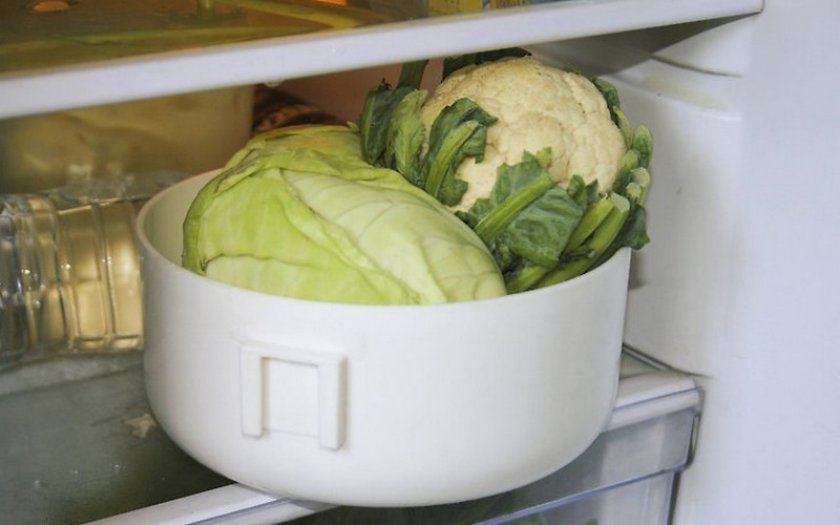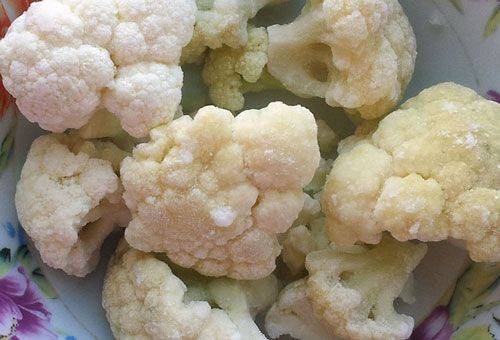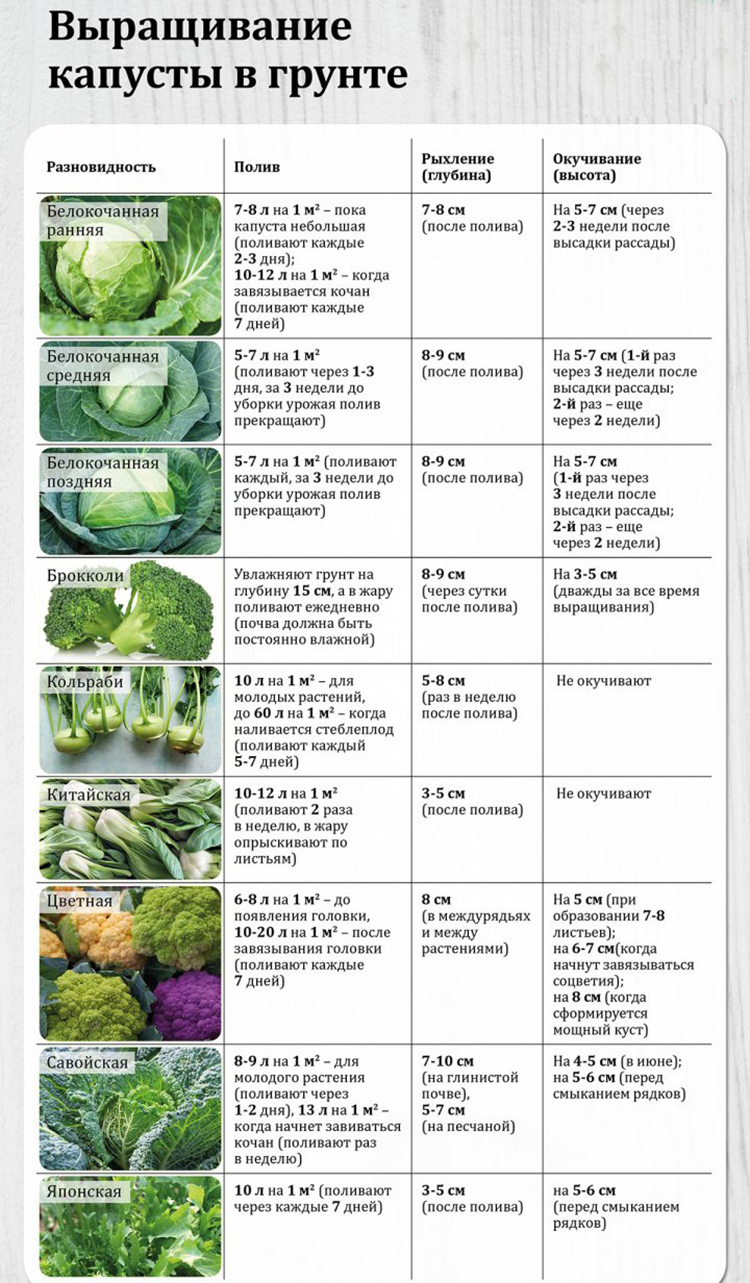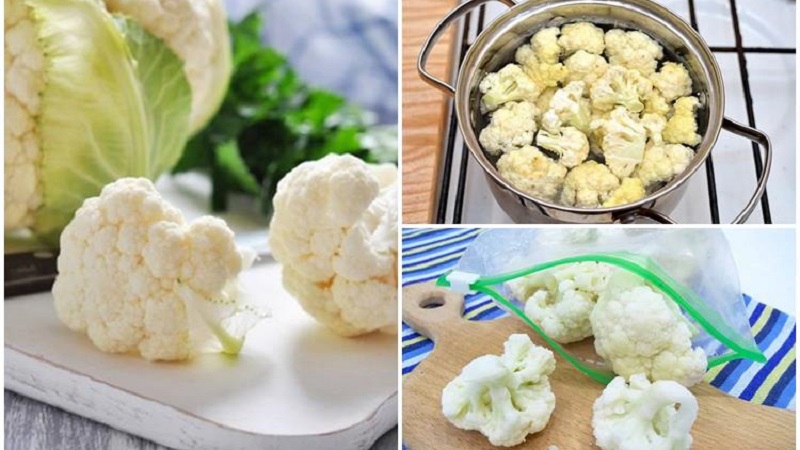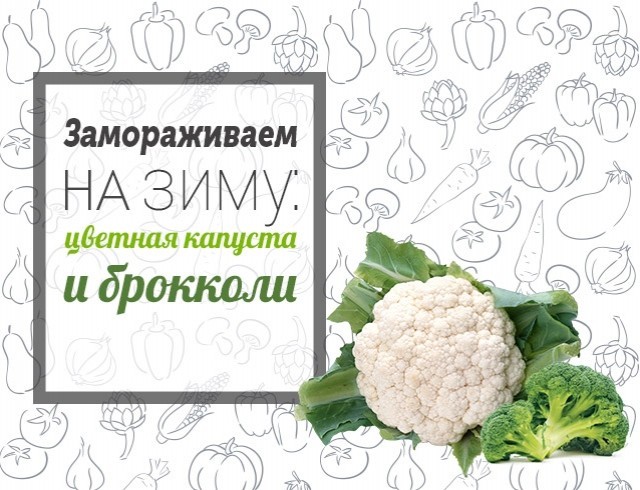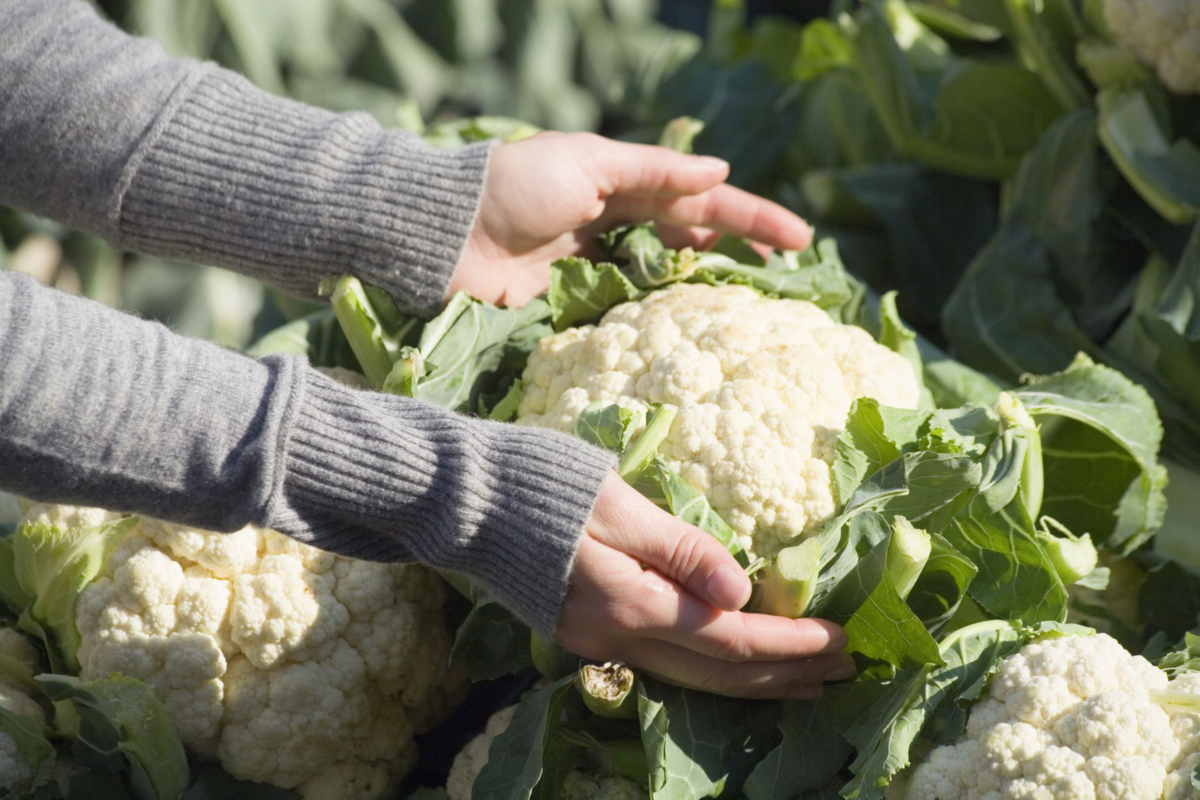How to store cauliflower in the refrigerator. How and how much cauliflower can be stored at home, rules and location
Cauliflower is a dietary vegetable containing vitamins C and B. It is better absorbed due to the soft structure of the inflorescences. But due to its softness, the variety is more sensitive to storage conditions than white cabbage. Cold and warmth are destructive for him. How the cauliflower is harvested and prepared and how it is stored determines the taste and benefits of the prepared dishes and preservation.
Features of storing cauliflower
What you need to know about a variety before choosing a storage method:
- none of the methods will preserve overripe heads of cabbage;
- unripe culture ripens after being collected in storage;
- with free access of air, heads of cabbage remain strong longer;
- cabbage tightly packed in a container spoils faster;
- in the cold, the inflorescences turn black, become bitter.
Overripe heads of cabbage are yellow, friable and disintegrate into inflorescences. With a lack of air and space, the vegetable releases waste products that accelerate decomposition.
The storage time of cauliflower is influenced by the integrity of its inflorescences. Crumpled, broken inflorescences can be put into storage.
How to prepare for long-term storage
What heads of cabbage can be stored:
- with a clean surface of uniform color;
- dense, with whole inflorescences;
- juicy.
Spots, yellowing, lethargy are signs of fungus and wilting. In storage, they will spread to healthy vegetables. Withering inflorescences will not pick up juice, and in dishes they will look like cotton wool.
What to do with cabbage after purchase or harvest:
- divide the heads of cabbage into parts;
- cut roots, leaves;
- Rinse;
- dry thoroughly.
In this form, the ripened heads are ready for laying in the refrigerator, drying, conservation. When collecting unripe heads of cabbage, they are dug up with a root and an earthen clod, seated in boxes or laid out in open glass jars, placed in a cellar. A ripening vegetable crop should be watered regularly.
Necessary storage conditions
Storage requirements:
- temperature - 0 ... + 6 degrees;
- darkness;
- good ventilation;
- 95% humidity.
The heads of cabbage turn yellow and dry from heat and sun. A cellar is most suitable for preserving fresh heads according to the conditions.

Home storage methods
The fridge and freezer are the best places to store cauliflower at home
It is important not to re-freeze the vegetable. Sensitive inflorescences will not withstand a new shock treatment and, upon the second defrosting, will turn into a tasteless porridge
In fridge
It is better to use a refrigerator to store purchased fresh vegetables in an apartment. In cling film, the inflorescences will remain for 2 weeks. You can use a plastic container with holes and place it in the vegetable compartment or place it on the door. Do not put cabbage under the freezer, on the upper shelves, near the far wall. These are the places with the lowest temperatures that are not suitable for long-term storage of the cauliflower variety.
In the freezer
The washed dry heads of cabbage are disassembled into portions, packed in cling film in 2 layers and loosely laid out in the freezer. If necessary, take out 1-2 portions, which will be enough for cooking at one time.
Before freezing, vegetables can be blanched: immerse in boiling water for 5 minutes, remove, dry and also wrap in plastic. Fresh frozen and blanched inflorescences are stored for an equally long time. Precooking better preserves the firmness of the product after defrosting. Before preparing food, the cauliflower is thawed in the vegetable compartment of the refrigerator.
In the cellar
When storing, it is important to spread the heads of cabbage at a distance from each other. The stock must be regularly reviewed and yellowed, blackened specimens removed
If you spread it out tightly and do not remove spoiled vegetables in time, the neighboring ones along the chain will quickly deteriorate, and then the entire crop.

In a clay chatterbox
For better isolation, the heads of cabbage, laid out in a container, are coated with clay diluted with water. Also, the heads can be dipped in a liquid clay solution, allowed to dry, laid out in the boxes in one layer and sprinkled with sand on top. But the negative side of this storage method is that it is difficult to check whether the heads of cabbage have gone bad or not.
In wooden boxes
A flat container with low sides will do. Heads of cabbage will fit in one layer. Drawers with loose-fitting boards have better air flow. The containers are placed in a row on the racks. On top of one box, you can put the second crosswise so as not to block the air for the lower vegetables.
Hanging
The advantage of the method is in saving space, ventilating and isolating the heads of cabbage. Hanging the cauliflower requires wood, metal strips and a thin rope.
It is possible to construct special frames for hanging inflorescences in several crossbars
It is only important to observe the interval between vegetables.
How to keep cauliflower in an apartment: tips
Without a cellar, you can use other ways to store cauliflower. If a vegetable grower has a glazed loggia where the air temperature does not drop below zero degrees, it is worth using it instead of a basement. The inflorescences are placed in a box of sand, covered with plastic wrap on top. In severe frosts, cabbage is insulated with an old blanket or fur coat.
In fridge
The temperature in the refrigerator is close to 7 degrees Celsius, so the cauliflower is stored there for a short time - about 2 weeks.
Storing cauliflower
The following actions will help to extend its life:
- heads are washed with cold water;
- dry on a napkin so that no water drops remain inside;
- wrapped with cling film in 2 layers;
- placed on the bottom shelf of the refrigerator or in the vegetable compartment.
In the freezer
Housewives use 2 ways to freeze cauliflower at home - with preliminary blanching of vegetables and without this procedure. Let's consider both options.
Freezing blanched cauliflower
The head is washed, disassembled into inflorescences and dipped in boiling salted water in small batches for 1-2 minutes. To prevent the vegetables from losing their natural color, add a little citric acid (0.5 tsp per 1 liter) to the pan. After the vegetables are thrown into a colander and allowed to drain. When the product cools and dries, it is packed in bags of 200-300 g and sent to the freezer.
Freezing fresh inflorescences
To save time, many housewives do not blanch vegetables, but freeze them fresh. First, the whole head is immersed in cool salty water for 15 minutes. This measure will help get rid of the insects that are hiding inside. Then the cabbage is sorted into inflorescences and dried on a towel. The product is packaged in plastic bags in small portions, tied tightly and sent to the freezer.
Drying
Dried cauliflower has a shelf life of about a year. It can be added to first courses or vegetable stews. There are two ways to dry raw materials - in a dehydrator or in an oven. In both cases, the head is first washed with running water and disassembled into small inflorescences.
The vegetable dryer will do everything by itself, you just need to put the vegetables in special trays and turn on the device, guided by the instructions. To dry the cauliflower in the oven, cover the baking sheet with baking paper, sprinkle inflorescences on it with a thin layer. The door is left ajar, fixing it with a wooden spatula. Drying is carried out at a temperature of 50-60 degrees until the vegetables have lost all moisture.
Canning and pickling
Cauliflower can be harvested for the winter. It is canned along with other vegetables - carrots, onions, zucchini, eggplants. It is also good marinated with vinegar, garlic and bell peppers. This appetizer will certainly be appreciated by the guests gathered at the festive table.
Having collected a rich harvest of cauliflower, you need to try to preserve it. The damaged heads are set aside for use in the near future, the rest are put in the cellar, after having previously treated it with antifungal agents. How to store vegetables - in sand, paper or clay mash, each gardener decides for himself. Those who do not have a basement will have to use the freezer, because cabbage will definitely not deteriorate at subzero temperatures.
Choosing and preparing heads
Before you start storing cabbage at home, you need to prepare it. Forks of medium size, tight, rounded, slightly flattened are best stored. If they went on sale in late autumn, therefore, they belong to late-ripening varieties intended for long-term storage. But there is a catch here. Loose specimens (even from late hybrids) are not suitable for storage. Early and mid-season varieties are also not suitable. Their savings period is limited to a maximum of three months.
But it is not only the variety that plays a role in the shelf life of fresh vegetables. Before harvesting, each forks must be carefully inspected. If cracks, damage from pests are found, they should be put aside and used as soon as possible. Be sure to cut off the remains of the stem. The stronger the better. Indeed, during long-term storage, cabbage begins to grow - it forms small heads of cabbage or starts up flower stalks.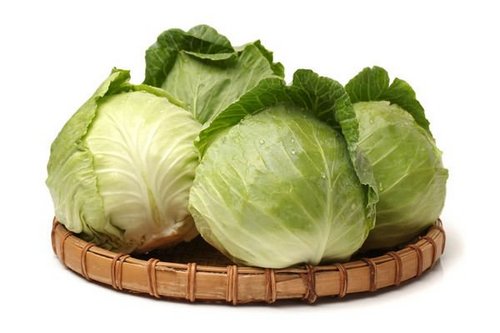
Also, the integumentary leaves are removed, leaving no more than a couple of leaves on the head. It must be remembered that these green leaves protect the forks from spoilage. Therefore, there is no need to peel the cabbage white. You should have smooth and beautiful heads of cabbage with several covering leaves.
Also, the forks must be washed in running cool water. Water must be pumped in to flush out stuck insects and residual soil or sand. Showers are best suited for these purposes. Then the heads of cabbage are wiped with a cloth, or with a waffle towel, so that there is no moisture left. This is the basis for how to preserve cabbage for the winter.
Storage period and methods
The duration depends on where the cauliflower will be stored. It is necessary to preserve the integrity of the fruits: they are very delicate and easily damaged, and this will quickly lead to their rotting. The best way is hanging, which will keep the heads of cabbage intact.
It is important to observe the conditions: the place should be cool, dark and humid. So the vegetable can stay fresh for months.
Heads of cabbage can be kept:
- in the basement, closet or cellar - the shelf life will be 2-3 months;
- in the refrigerator - no more than one month;
- in the freezer - up to 1 year;
- on an insulated balcony - up to 1 month.
How to store cauliflower in the refrigerator
The washed and dried heads of cabbage are placed in cling film or paper towels
It is important that the fruits do not come into contact with each other, so wrap each head separately. They can also be placed in a glass jar and sprinkled with coarse salt.
In a cellar or basement
With this method, temperature and humidity are of great importance: the vegetable is stored at 0 ° C and about 95%, respectively. For storage, choose wooden boxes or boxes. Heads of cabbage must be cleaned of roots and leaves, placed in boxes, covered with plastic wrap. So they can stay fresh for 6-7 weeks.
However, it is important to regularly sort out the fruits in order to identify the processes of decay.
You can also store the heads of cabbage in a suspended state: with the above indicators, they will be fresh for 3 weeks.
In the freezer
Freezing is the most efficient way. The inflorescences can be kept in the freezer for up to one year. You can freeze both fresh and blanched heads.Cabbage can also be kept in boiling water for 3 minutes, and then quickly cooled in running water: prepared in this way, it will remain white even after freezing.
Before freezing, the heads should be disassembled, then rinsed well and dried. Keep vegetables in the freezer in separate package. All air must be removed from the bags: this will ensure long-term storage.
Canning
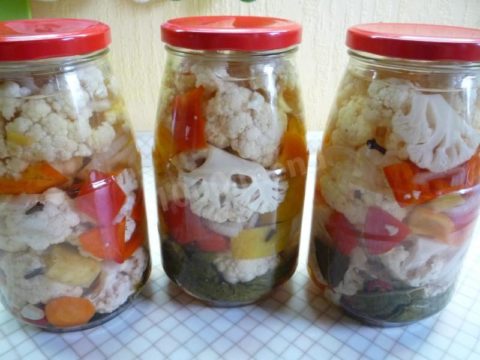 Salting is the best way if you will use the vegetable for cooking hot dishes. For salting, table salt and vinegar 9% are used.
Salting is the best way if you will use the vegetable for cooking hot dishes. For salting, table salt and vinegar 9% are used.
The cabbage must first be blanched: for this, the disassembled inflorescences are boiled for 2 minutes. Salt is added to the water, you can also add various seasonings and inflorescences: pepper, cloves, bay leaves. After the water boils, add vinegar. Then the vegetable is laid out in jars and rolled up.
Canned cauliflower is stored in a dark place. Salted or pickled cabbage can be stored for a very long time. If it has not been rolled up, then it can be kept in the refrigerator for 1-2 months.
How to store cabbage in the cellar until spring
You can save cabbage until spring in a cellar at a temperature of -1 ... + 1 ℃ and an air humidity of 85-95%. The creation of a favorable microclimate will protect the vegetable from rotting, will help to preserve the juiciness, taste and the whole range of nutrients.
Before storing cabbage in the cellar, carefully clean, ventilate and dry the room. If necessary, disinfect, destroy rodents and other pests.
You can store cabbage in the cellar in different ways. The choice depends on the amount of harvest, the size of the room and the preferences of the hostess.
An easy way to store is in drawers. Before laying, cut the stumps (3-4 cm should be left) from all heads, do not remove the top layer of leaves. Place the cabbage in wooden crates that have ventilation holes. Arrange the blanks in the cellar by placing them on a stand or pallet. This will protect the product from excessive moisture and prevent rotting.
A simple and economical way to store cabbage - in boxes
An important condition is the presence of ventilation holes in the container, which will ensure good air circulation and protect the crop from decay. Sand will help preserve the maximum of nutrients in cabbage.
Peel the heads of cabbage from the top layer of leaves (leave 2-3) and cut off the stalk (3-4 cm should be left). Fold the products into a box and sprinkle each layer with sand, which must first be dried and calcined. This method is quite effective, albeit dirty.
Sand will help to preserve the maximum of nutrients in cabbage. Peel the heads of cabbage from the top layer of leaves (leave 2-3) and cut off the stalk (3-4 cm should be left). Fold the products into a box and sprinkle each layer with sand, which must first be dried and calcined. This method is quite effective, albeit dirty.
You can store cabbage in the cellar in the form of a vegetable pyramid. Place a pallet or knocked-down boards on the floor so that there is a gap between them. This will provide air circulation and extend the shelf life of the vegetables. Lay on them the largest and densest heads of cabbage, then in a checkerboard pattern, medium and then small. The result should be a stable vegetable pyramid.
You can save cabbage in paper. This method will provide thermal insulation, protect the fruit from moisture, light and contact with other vegetables. Wrap the selected whole heads of cabbage in several layers of paper and put them in boxes or bags. You can store such a blank in a cellar or basement.
Clay wrap will help preserve the cabbage. Pre-sort the vegetables and remove the top sheets. Gently wrap each head of cabbage tightly in plastic (in three layers). The created vacuum will protect the vegetable from pathogenic microorganisms, pests and negative environmental influences. Arrange the prepared vegetables on the shelves in the basement or put them in boxes.
An unusual way to store cabbage - hanging:
- Nail a wooden board into the cellar and drive nails into its side at the same distance.
- Tie a rope to the stump of each head of cabbage.
- Hang the cabbage over the nails.
This storage will provide constant airing of the vegetables and prevent them from rotting. In addition, with this method, it is convenient to monitor the condition of the cabbage and use, first of all, the one that has begun to lose its presentation.
To preserve cabbage for a long time, choose late-ripening varieties, carefully select and sort products, and also create a favorable microclimate for vegetables.
Storage methods
There are several ways to store cauliflower, each of which has its own characteristics and rules. Study them and decide how you will store your cauliflower.
In fridge
You can keep the cauliflower fresh by using the refrigerator. How it happens: the vegetable is divided into inflorescences, after removing the leaves. Then they are wrapped in paper or cling film and sent to the refrigerator on a shelf for storing vegetables. If a long storage time is involved, the wrapper should be changed periodically.
Sometimes the inflorescences can rot, it is worth monitoring this and removing the damaged elements. If you will be storing cauliflower in the refrigerator, remember not to allow sudden changes in temperature. Otherwise, the vegetable will turn gray and no longer fit for food.
You can extend the "life" of a vegetable if you salt it. To do this, place individual inflorescences in a jar and fill with brine. It consists of water and salt (calculating 1 liter of water per 1 tbsp. L. Table salt with top). When preparing any dish, the brine is simply washed off with water.
In the freezer
When the question arises of how to save cauliflower for the winter, the freezer will be the safest place. Before freezing, the product should be disassembled into inflorescences. You can blanch them or boil them in salted water, but no more than 5 minutes. After heat treatment, the vegetable must be dried well. Divide it into containers or bags. It is advisable to sign the procurement date on them.
You should periodically shake the container with the frozen product so that individual inflorescences do not stick together into one lump. Do not re-freeze it. Therefore, it is recommended to send to the camera in batches. You can freeze fresh cauliflower. But this method has its drawbacks. Damage to the product is possible.
In the cellar
Another way to keep your cauliflower fresh for a long time is to use your basement or cellar. Hanging heads of cabbage is an excellent option here. The inflorescences remain intact, which automatically extends the shelf life.
If you put the heads of cabbage in wooden boxes, then the forks should not touch each other. This can provoke a decay process. From above, the container is covered with polyethylene. It is necessary to constantly monitor that condensation does not collect. In the absence of boxes, you can lay out the cabbage on wooden shelves. With this method of storage, it will be necessary to constantly turn the specimens, and tear off the spoiled leaves.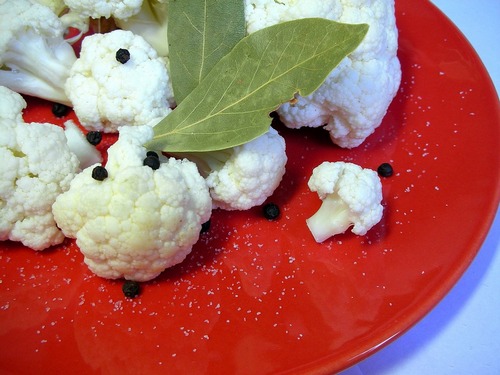
Clay wrapping perfectly preserves cabbage. You just need to coat each head with a solution, the consistency of which is similar to sour cream. After that, they are usually dried and hung under the ceiling of the cellar.
Cabbage is well preserved in a layer of sand. To do this, make a slide out of it, and deepen the fruit along with the roots.
On the balcony
A good option is to store the cauliflower on the balcony. The main thing is to make sure that the temperature does not drop below zero. The rest of the conditions are the same as those required for storage in the cellar.
How to keep cauliflower out of the refrigerator. How and where to store cauliflower correctly?
Overripe cauliflower cannot be stored.It can be eaten, but the taste may differ from traditional characteristics. Overripe inflorescences can be identified by the degree of their disclosure and distance from each other. Otherwise, cauliflower can be stored for quite a long time. Heads of cabbage can ripen even if they are cut at the first stage of flowering.
The nuances of storing cauliflower at home:
- The hanging method is considered an ideal option for storing cauliflower (the inflorescences in this position are not deformed or damaged, which increases the shelf life of the head);
- it is necessary to store cabbage in a dark and cool place with sufficient ventilation (from a lack of oxygen or high air humidity, the head of cabbage will quickly begin to deteriorate and acquire a pungent odor);
- it is not recommended to store the heads of cauliflower in contact with each other (the decay process in this case may accelerate);
- you can store cauliflower inflorescences without leaves, after wrapping them with paper or newspaper and placing them in a cool dark place (you can store cabbage in this way in the refrigerator);
- in the refrigerator, cauliflower inflorescences can be stored in cling film (in this case, it is better not to use plastic bags);
- from sudden temperature changes or too long storage in the cold, cauliflower may begin to acquire a black or dark gray tint (the taste will be bitter and it will be difficult to eat such cabbage);
- freezing cauliflower is considered the most effective way to store it (temperature drops and repeated frosts are not allowed);
- it is recommended to freeze cauliflower in the form of disassembled inflorescences (beforehand, the inflorescences can be blanched in slightly salted water, which will preserve their white color);
- if you re-freeze cauliflower, then when defrosting, its consistency will resemble porridge;
- disassembled cauliflower inflorescences can be sprinkled with coarse salt and placed in glass jars (the blanks must be stored in the refrigerator, and instead of lids it is better to use parchment paper);
- in the refrigerator, cauliflower should not be placed in the coolest zones (this temperature is not suitable for storing cabbage, therefore, it must be placed either closer to the vegetable compartment, or choose another storage location);
- only dry inflorescences need to be frozen (after washing, dry them with a towel or wait for the natural evaporation of moisture).
Storing cauliflower at home: methods, timing, preparation for storage
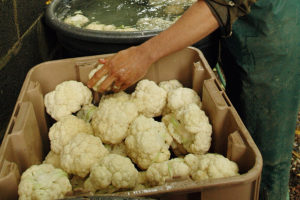
Cauliflower contains a large number of valuable elements and is very beneficial for humans. It is advisable to use it throughout the year and especially in winter. However, this vegetable must be stored correctly. You will learn about the methods and features of storing cauliflower at home from the article.
Which varieties of cauliflower last longer
In order for the vegetable to be fresh for a long time, to remain attractive in appearance and to retain valuable substances in it, it is necessary to choose a suitable variety for this. It was noticed that late varieties are stored for the longest time, and early varieties are worst of all.
Among the late cauliflower, the best varieties are Amerigo, Asterix, Cortes, Adler winter 679, Sochi, Adler spring.
In addition to a good choice of variety, in order to preserve vegetables well, they must be removed in a timely and competent manner. Here are some rules for harvesting:
- At the time of harvest, the fruits should reach a diameter of 8–12 cm and a weight of 0.3–1.2 kg.
- The heads should be carefully cut off with a sharp knife, leaving 2-3 leaves on them.
- Cut heads of cabbage should be immediately removed to a dark place to avoid exposure to the sun's rays.
- Cleaning should be completed before the onset of frost, otherwise the cabbage will turn gray and taste bitter.
Early varieties must be harvested 80-110 days after the emergence of sprouts, early-ripening - after 115-120 days, mid-ripening - after 125-135 days, late-ripening - after 145-170 days
How to properly prepare cauliflower for storage
High-quality fruits should be selected before storage. They must meet the following characteristics:
- not be damaged;
- be without signs of rot, without black dots;
- be moderate, but not completely loose.
Remove roots and leaves before laying. If freezing is planned, then it is advisable to blanch: a boiled vegetable can lie much longer.
Important! Overripe fruits with yellowed foliage should not be stored for storage.
in the freezer
the longest storage method for a vegetable is freezing. to implement it, you must adhere to the following instructions:
- wash the heads.
- divide them into inflorescences.
- dip them in freshly boiled water and boil for 3-4 minutes.
- remove the boiled inflorescences and dip them in ice water.
- spread the inflorescences on a baking sheet so that they do not come into contact with each other.
- freeze them quickly.
- remove the inflorescences from the freezer and put them in bags, releasing air from them, or in plastic containers.
- put the vegetable back in the freezer.
you need to prepare a frozen product in the future without defrosting.
in the cellar
in a cellar or basement, a vegetable at a temperature of 0 ° C, humidity of 95% and good air circulation can be stored in several ways:
- in boxes made of wood or plastic, covered with plastic wrap.
- in cardboard boxes.
- in limbo.
- in a bucket of sand.
- on the rack.
- processed with a clay talker.
important! Cabbage placed for storage should be periodically inspected and spoiled specimens should be discarded. in the cellar, you can store not only the harvested crop, but also the transplanted
if frosts came before the heads were ripe, then the plant can be dug up with roots and transplanted in containers, covering the lower leaves with earth. in the first 2 days they need to be watered well. optimal conditions for growth: temperature - from + 4 ° C to + 10 ° C, humidity - 95%
in the cellar, you can store not only the harvested crop, but also the transplanted one. if frosts came before the heads were ripe, then the plant can be dug up with roots and transplanted in containers, covering the lower leaves with earth. in the first 2 days they need to be watered well. optimal conditions for growth: temperature - from + 4 ° C to + 10 ° C, humidity - 95%.
on the balcony
on the balcony, the cabbage must be hidden from the sun's rays, otherwise it will quickly deteriorate
it is also important to ensure that the vegetable is not exposed to frosty temperatures, so an uninsulated balcony is not suitable as a place for winter storage
storage periods
How much a vegetable will be stored depends on how it is stored. The maximum storage times can be found in the table:
| Storage method | Storage duration |
| in the cellar in boxes | 7 weeks |
| hanging in the cellar | 3 weeks |
| in a cellar in clay | 6 months |
| in a cellar in the ground | 4-5 months |
| on the balcony | 4 weeks |
| in fridge | 2-3 weeks |
| in the freezer | 6 months |
| in the freezer after blanching | 12 months |
So, there are several ways to store cauliflower at home. The duration of its saving depends on which method is chosen. The vegetable can be stored for the longest when frozen and processed with a clay mash in the basement.
Harvesting cauliflower
To get a good crop harvest, it is extremely important to remove it from the garden on time and competently - then the product will not lose its valuable taste and nutritional qualities.
Optimal collection times
Check out
Early, mid and late cauliflower varieties
The collection time, like the ripening time, depends on the variety of the planted vegetable:
- For early varieties, the best harvest time is the last days of June - the first decade of July.
- For mid-season varieties, the best time to harvest is late July - early August.
- For late ripening, the optimal harvest time is the last days of August and September. Moreover, such varieties are better and longer stored.
If the vegetable is not removed from the garden in time, then it will begin to sprout and become unusable, which most often occurs in the last days of August and in autumn, in warm and humid weather.
Collection technology
In order not to ruin the grown crop, you need to know at what time and how to properly remove cabbage fruits from the garden, as well as how long they can be left in the open field.

The rules for cutting heads of cauliflower are as follows:
- The crop is harvested from the garden sequentially - this means that every two to three days a maturity check is carried out with immediate harvesting of ripe cabbage.
- Harvesting is carried out on a sunny day at a temperature of + 8 ° C and above.
- The best collection time is from 2 pm to 7 pm.
- The heads must be cut off with a sharp knife, but in no case break off.
- The cabbage is cut 3-5 cm below the head (see photo).
- When cutting, grab 5–6 lower leaves.
- The harvested crop is transferred to a cold storage deprived of light. If the vegetable stays under the sun for more than 5 hours, it may lose its color and taste.
Important! You should not harvest immediately after the rain - cabbage will lose its inherent taste, aroma and will not be able to be stored for a long time.
How to store cauliflower at home
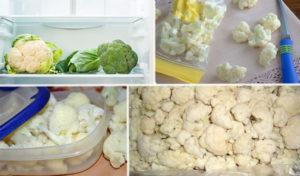
Vegetables are an irreplaceable storehouse of vitamins for the human body. Knowing some secrets, you can eat fresh plant foods all year round. Storing cauliflower at home without losing its valuable properties is feasible in several ways.
Rules for storing cauliflower at home
Harvesting
Even a novice gardener is capable of growing and preserving then cauliflower. This vegetable needs warmth, regular watering and feeding, but it is better to avoid direct exposure to the sun beds.
The traditional harvest time is from July to early August, but the peculiarities of the variety play a role here. The quality and degree of preservation of the vegetable depends on the literacy of the collection.
- cut off the inflorescences when they reach 10-15 cm in diameter;
- a ripe vegetable needs immediate removal from the garden;
- a tool for cutting the heads - a sharp knife: the inflorescence is captured together with the lower leaves;
- will properly store freshly harvested and fresh cauliflower in a dark and cool place.
If weather conditions require immediate removal of seedlings from open soil, transplant them into a greenhouse or cellar to grow there.
Storage methods
In autumn and winter, the body needs vitamins. It is quite possible to carry them with you from summer
The correct harvesting technique affects the duration of the preservation of vegetables, which is why it is so important to cut the inflorescences on time. You can store cauliflower at home without losing its beneficial properties in certain places and using different methods.
Cellar
To preserve cauliflower for the winter, you need to keep it in a cellar. If the temperature in the storage does not meet the required conditions, you can start some tricks.
- Pre-lubricated and dried in clay, it will remain useful for six months. Prepare a thick solution and lubricate each head with it.
- A similar shelf life will ensure that the culture is stored in a bucket of sand.
- The containers in which you will store the cauliflower must be wooden. Cover the boxes with plastic wrap. Another option is hanging shelves.
Make sure that condensation does not form under the shelter. Check vegetables for diseases. It is allowed to store cauliflower in the cellar for the winter for 2-3 months.
Suspended state
A vegetable suspended by a stump to a bar will last about a month in the cellar.If you decide to use this method to preserve your cauliflower, uproot the plant along with the stem when cutting. Tear off the overgrown leaves from it periodically.
Fridge
Cabbage can be stored in the refrigerator for two weeks.
Refrigerating cauliflower is not the best option if you want to stock up on vegetables for a long time. In the refrigerator, the product must be securely covered. You can wrap it in cling film (in 2 layers), paper or an airtight bag - each head of cabbage will need a separate one. You can save cauliflower without losing freshness, only for 2 weeks.
To properly store cauliflower in the refrigerator, you must first cut off the leaves and roots. Keep the culture in the upper compartments.
Freezer
To keep the cauliflower in the refrigerator for a long time, you can opt for the freezer. The culture can be placed there in any form:
- whole;
- chopped into inflorescences;
- fresh;
- steamed in boiling water.
This is the best way to preserve cauliflower for the winter. A well-tamped product can lie in the chamber without losing its usefulness for about a year.
Other storage methods
In case none of the described methods of how to keep cauliflower healthy came up, pay attention to other, less popular, but effective ways to solve the problem. Dry the inflorescences in the oven at a temperature of 60-70 degrees, arrange in plastic containers
Expiration date - 1-2 months
Dry the inflorescences in the oven at a temperature of 60-70 degrees, arrange in plastic containers. The shelf life is 1-2 months.
In salted / pickled form, the culture has no expiration date. The selection of heads for conservation must be careful: dense, white specimens without germinated inner leaves are suitable.
How to store cauliflowerHow to Freeze Cauliflower for the WinterHow to Harvest Cauliflower for the Winter


